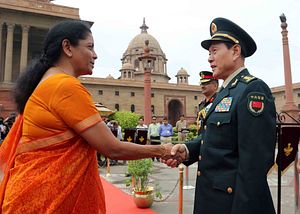A year after the Doklam standoff, which plunged India-China relations to their lowest point in decades, Chinese Defense Minister and State Councilor Wei Fenghe’s recent visit to India marked another effort in setting a positive tone between the neighbors. Amidst the growing tensions and instability in New Delhi-Beijing relations, Wei’s trip from August 21-24 was considered as a landmark meeting aimed at revamping and rebuilding cooperative mechanisms. Though the visit was not aimed at formalizing any agreement, yet there was a colloquy all over that it will boost and promote cordial relations.
At the same time, though, India is trying to build its military and defense relations with Japan, whose own relations with China are souring due to territorial and sovereignty issues in the East China Sea. Wary of growing Chinese assertiveness and influence, India is also taking measures to deter Chinese aggression in the Indian Ocean and the extended neighborhood. Given these factors, we may be expecting too much from trust-building measures like Wei’s visit. There are limitations to Sino-Indian relations due to differences on the long pending border disputes, India’s threat perception of growing Chinese military capability in the Indian Ocean, and issues related to the China-Pakistan Economic Corridor (CPEC).
Since the denouement of the Doklam standoff, there have been frequent exchanges by both sides to build the relations and trust. Indian Prime Minister Narendra Modi visited China, as did Indian Defense Minister Nirmala Sitharaman. Now it is Wei’s turn to visit India. We have also seen the ramping up of military ties through joint military exercises like “Hand in Hand.” Though these various visits and meetings might point toward a new beginning, yet there are areas where both sides do not wish to bend or change the status quo. This gap needs to be bridged before counting too much on the overlapping areas of interests between the two giant economies of Asia.
A closer look at confidence-building measures reveals the lingering tensions. Though both countries have agreed to reset the military hotline between New Delhi and Beijing, the picture is still blurred as the wrangle continues as to which level it should be established at the headquarters. India wants the hotline to be operationalized at the Director General of Military Operations (DGMO) level on both the sides, while China maintains that it should be between the deputy commander of the Chengdu Western Theater Command and Indian DGMO. Such fundamental issues require more attention if these confidence-building measure are to be sustained.
Simultaneously, India is also rebooting its military and defense ties with Japan to further increase its role and influence in the Indo-Pacific region, thereby clinging to its multipolarity approach. Recently, Japan’s Defense Minister Itsunori Onodera preceded Wei in visiting India to strengthen and reinvigorate its defense ties, thus calling for a more diplomatic balancing role by India. India is also preparing for its first bilateral exercise with Japan in counterterrorism. While practicing multipolarity, whether India will be able to distribute its eggs in different baskets strategically and successfully remains a question.
Being a member of the Quadrilateral Security Initiative, India — along with the United States, Japan, and Australia — has also reinforced the importance of a free, open, and inclusive Indo-Pacific. In the Quad countries’ discussions on maritime security, it was emphasized that all members should work collectively to oppose the establishment of permanent Chinese military bases, thus signalling to China that any act of aggression will not be tolerated. As a keynote speaker at this year’s Shangri-La Dialogue, Modi clearly pointed to displeasure over China’s activities in the region, especially focussing on the use of global commons and connectivity projects which should be based on building trust and not only infrastructure. Modi’s remarks signalled that India will not compromise with sovereignty issues. Considering the geopolitics of Chinese connectivity projects, especially CPEC, which passes through Pakistan-administered Kashmir, New Delhi has always shown strict resistance to the larger Belt and Road Initiative.
Visits like Wei’s have taken in the past too. However, unless fundamental issues are settled, there can be no promise of better bilateral relations between the neighbors. Sowing the seeds for further cooperation, is a mere dream without tackling problems like the long-standing border dispute, China’s opposition to India’s entry in Nuclear Supplier’s Group, and the cross-border terrorist organizations causing tensions between India and Pakistan, China’s “iron brother.”
The time is apt to reconsider whether such formal and informal talks are enough to solve the complicated China-India relationship amidst the changing tide of geopolitics. In looking at Wei’s visit, are we forecasting a good harvest without counting on the changing weather conditions? While cooperative behavior between India and China should be embraced, expectations should be premised on India’s ability to manage its other bilateral relationships.
Radhey Tambi is a post graduate research scholar at the Department of Geopolitics and International Relations, Manipal Academy of Higher Education, Manipal, India.

































